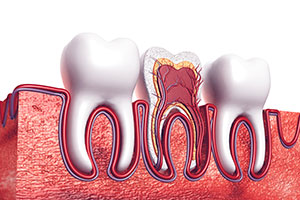 The Role of CBCT Scans in Modern Endodontics
The Role of CBCT Scans in Modern Endodontics
Advancements in dental technology have transformed the way we diagnose and treat problems inside the tooth. One of the most significant innovations in recent years is the use of cone beam computed tomography (CBCT), a specialized type of 3D imaging that provides detailed views of the teeth, jaw, and surrounding structures. Unlike traditional X-rays, which produce flat, two-dimensional images, CBCT scans allow us to examine teeth from multiple angles with remarkable precision.
What Is a Cone Beam CT Scan?
A cone beam CT scan uses a rotating arm to capture a series of images from different directions. These images are compiled into a three-dimensional model that reveals the internal anatomy of a tooth and its relationship to nearby tissues. The process is quick, noninvasive, and typically takes less than a minute. For patients, the experience is similar to having a panoramic X-ray, but the information gained is far more comprehensive.
Why Is 3D Imaging Important in Endodontics?
Root canal systems are often complex and difficult to visualize fully with conventional imaging. Tiny accessory canals, unusual curvatures, and hidden fractures can be easily missed on standard X-rays. A CBCT scan allows endodontists to see the entire root canal system in three dimensions, which improves the accuracy of diagnosis and helps avoid complications during treatment. Whether we evaluate a tooth for retreatment, trauma, or unusual anatomy, 3D imaging often provides the clarity needed to make the best clinical decisions.
How CBCT Improves Diagnosis and Treatment
One of the key benefits of CBCT imaging is its ability to detect issues that may not be visible with traditional radiographs. Small lesions, resorptive defects, and vertical root fractures are often more apparent in 3D scans. This allows endodontists to identify the source of pain or infection more reliably and tailor treatment plans with greater precision.
Patient Safety and Radiation Exposure
While CBCT scans do involve exposure to radiation, the levels are significantly lower than those used in medical CT scans. The equipment used in dental offices minimizes radiation and targets only the area of concern. Endodontists use CBCT selectively and only when the benefits clearly outweigh the risks. When necessary, this imaging tool can mean the difference between saving a tooth and losing it due to incomplete or inaccurate treatment.
The Future of Precision Endodontics
As technology continues to evolve, cone beam CT imaging is becoming an integral part of endodontic care. Its ability to reveal the unseen, guide treatment with confidence, and improve outcomes makes it one of the most valuable diagnostic tools available today. For patients, it means less guesswork, fewer complications, and a higher chance of saving their natural teeth!





Comments are closed.